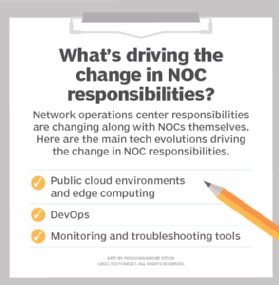
Petya Petrova - Fotolia
How are network operations center responsibilities changing?
If your network operations center responsibilities haven't changed yet due to evolutions like DevOps and edge computing, they likely will soon. Here's what you need to know.
While the overall purpose of a network operations center, or NOC, hasn't changed, many of the corresponding responsibilities have. Although each NOC is designed and managed differently, certain enterprise evolutions have either affected an organization's NOC already or likely will in the future.
Let's look at a few of the more popular evolutions forcing responsibility changes in the enterprise NOC:
- public cloud environments and edge computing
- DevOps
- monitoring and troubleshooting tools
3 top changes with network operations center responsibilities
Responsibility changes due to public cloud environments and edge computing
NOC staff used to manage the entire infrastructure stack from bottom to top. Of course, architecture evolutions are moving company applications and data into public cloud environments and the metro edge. Thus, NOC staff no longer maintain the underlying cloud infrastructure.
That said, NOC teams still must monitor the environment. This means that, internally, the NOC's priority has shifted more toward rapid problem identification and less on problem remediation.
Responsibility changes due to DevOps
DevOps is the practice of implementing frequent software changes quickly using an agile, process-oriented approach. DevOps requires developers and operations staff to be on the same page when it comes to the changes made to production software and how to respond when those changes have unforeseen effects on the organization.

As changes to business software are made through developer updates and patches, NOC teams must understand how those additions and changes could negatively affect the network. For example, if a new feature is added to an application that suddenly requires greater amounts of bandwidth to operate, NOC staff must get involved to verify that sufficient throughput overhead is available. Otherwise, the application could experience performance issues due to a bottleneck on one or more network links.
Responsibility changes due to monitoring and troubleshooting tools
Because businesses have become so reliant on technology, NOCs have become more important than ever. Speed to resolution is critical -- and having the right troubleshooting and root cause analysis tools has become an absolute must.
Modern monitoring and troubleshooting tools take advantage of innovations in machine learning, AI and automation. NOC staff can use these tools to collect and analyze network health data to identify network problems they must resolve. Thus, the responsibilities of a NOC engineer have shifted away from manual troubleshooting and problem resolution to responsibilities that ensure AI-powered tools operate as intended.







